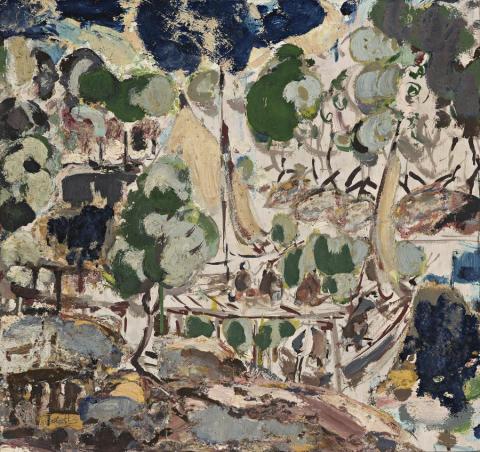ALLIGATOR CREEK, CAIRNS, 1939
IAN FAIRWEATHER
oil and gouache on cardboard
47.5 x 50.5 cm
signed lower left: I Fairweather
Collection of Lina Bryans, Melbourne
Thence by descent
Private collection, Melbourne
An Exhibition of Modern European Paintings and Sculpture, Melbourne Town Hall, Melbourne, 1948, cat. 37
Fairweather: a Retrospective Exhibition, Queensland Art Gallery, Brisbane, 3 June – 4 July 1965; Art Gallery of New South Wales, Sydney,21 July – 22 August 1965; National Gallery of Victoria, Melbourne, 9 September – 10 October 1965; National Gallery of South Australia, Adelaide, 26 October – 21 November 1965; Western Australian Art Gallery, Perth, 9 December 1965 – 16 January 1966; Tasmanian Museum and Art Gallery, Hobart, 10 February – 13 March 1966, cat. 73 (label attached verso)
Ian Fairweather 1891-1974, National Gallery of Victoria, Melbourne, 25 September – 6 November 1991(label attached verso)
Forwood, G., Lina Bryans: Rare Modern 1909–2000, Miegunyah Press, Melbourne, 2003, pp. 89, 181
Bail, M., Fairweather, Murdoch Books, Sydney, revised edition 2009, pp. 59–61, 213, 248, cat. 44, pl. 37 (illus.)
Alligator Creek, Cairns, 1939, oil and gouache on cardboard, 50.2 x 51.2 cm, private collection, Melbourne, Bail cat. 43, pl. 36
In June 1939 the peripatetic Ian Fairweather moved to Cairns. He eventually settled in Malay Town on Alligator Creek - in the outskirts, among the mangroves, and, like himself, other human outcasts, the Malays, Aborigines and Islanders. His home was a shared boathouse. Writing to Jock Frater in Melbourne, he said, 'I felt at home again ... It is like a little bit of the islands ...'1 Within a month he had completed and dispatched four oils to Frater, including Alligator Creek, Cairns, 1939. Commenting on their significance, Murray Bail acknowledged them as 'the first of his rare Australian subjects: earth, water, foliage and humid sky are one, producing for Fairweather his characteristic 'pattern'. Painted on the spot, they have no pencil work.'2 Like Boats at Soochow Creek, 1938, Alligator Creek, Cairns, 1939 continues the informal, window view of the landscape, with its characteristic high viewpoint. The sky is almost eliminated for an overall two-dimensional effect, creating once again the mural or tapestry look. The closeness of focus is almost intimate, drawing the viewer into the painting. There is a spontaneity of handling and a liveliness of touch in this celebratory transformation of the pictorial into a superb work of art. Although two seated figures occupy the painting's centre, Fairweather integrates them into the picture, dispensing with any central point of interest for the overall. Colour as form echoes form, as colour likewise complements colour. Here is the characteristic sureness of touch and variety that distinguishes the best of Fairweather's work. Moreover, the liveliness of the picture surface gives the painting a chatty quality, although its engaging busyness is the pathway to an inner tranquillity and serenity. In addition to its considerable aesthetic appeal, Alligator Creek, Cairns has added significance by being one of the four last oil paintings Fairweather completed before turning to gouache in July 1939.3
Years later, in 1964 at Bribie Island, Fairweather recollected his Alligator Creek days with the greater freedom of abstraction in the painting Malay Village. Here, a lattice of black figurative suggestions of houses sport over a field of yellows and mixed colours in synthetic polymer paint and gouache. Fairweather preferred to call Malay Town a village.4
1. Ian Fairweather to Jock Frater, July 1939, quoted in Bail, M., Fairweather, Murdoch Books, Sydney, revised edition 2009, p. 59
2. Bail, op. cit., p. 59
3. Bail, ibid
4. See Bail, p. 259, cat. 204, pl. 188
DAVID THOMAS
